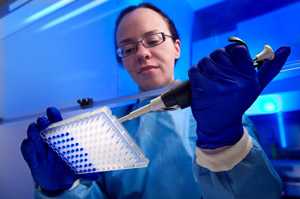Changes in Clinical Diagnostics and Tracking Infectious Diseases
Tuesday, October 18, 2016, at 1 pm EDT
 When it comes to tracking infectious diseases and outbreaks, determining who is infected with a particular pathogen is the first step in solving the puzzle and stopping the spread of the disease. Traditionally, culture testing has been the primary means of identifying the specific pathogen. With this method, cultures must be evaluated in a lab setting, and results can take two or three days. Culture-independent diagnostic tests (CIDTs) are a new method for diagnosing infections, and they are often used to identify foodborne illness. CIDTs work by detecting the presence of a specific genetic sequence or antigen of a germ.
When it comes to tracking infectious diseases and outbreaks, determining who is infected with a particular pathogen is the first step in solving the puzzle and stopping the spread of the disease. Traditionally, culture testing has been the primary means of identifying the specific pathogen. With this method, cultures must be evaluated in a lab setting, and results can take two or three days. Culture-independent diagnostic tests (CIDTs) are a new method for diagnosing infections, and they are often used to identify foodborne illness. CIDTs work by detecting the presence of a specific genetic sequence or antigen of a germ.
These newer tests are faster, and results are available much sooner than with traditional culture tests. However, CIDTs don’t identify the exact organism that caused the illness, and they don’t provide some of the more detailed information that culture tests can. For example, CIDTs don’t tell us what specific strain of an illness someone has, or how it may respond to antibiotics. Using only CIDTs makes it more difficult to connect individual infections to the same strain and to identify outbreaks.
This session of Public Health Grand Rounds discusses how CIDTs are changing the landscape of diagnosing infectious disease. Speakers will also discuss how the tests are evolving, and how some states are adapting to using CIDTs in their public health systems.
Presentation
Beyond the Data – Changes in Clinical Diagnostics and Tracking Infectious Diseases
In this session of Beyond the Data, Dr. Phoebe Thorpe and Alicia Cronquist, RN, MPH, discuss culture-independent diagnostic tests (CIDTs) and how they are changing the landscape of tracking infectious diseases. Tune in to hear how these tests are different from traditional laboratory cultures, and learn how some states like Colorado are addressing the challenges of using CIDTs in the field.
Presented By:
Chris Braden, MD
Deputy Director
National Center for Emerging and Zoonotic Infectious Diseases, CDC
“The Impact of Culture-independent Diagnostic Testing in Foodborne Diseases”
Alicia Cronquist, RN, MPH
Foodborne Disease Program Manager, Communicable Disease Branch
Colorado Department of Public Health and Environment
“Managing New Diagnostic Tests in Colorado”
Brad Spring, BS
Vice President, Regulatory Affairs & Compliance
BD Life Sciences (representing AdvaMedDx)
“Advancing Diagnostic Innovation and Public Health Needs”
John Besser, PhD
Deputy Chief, Enteric Diseases Laboratory Branch
Division of Foodborne, Waterborne, and Environmental Diseases
National Center for Emerging and Zoonotic Infectious Diseases, CDC
“Next Steps: Direct-from-specimen Testing to Characterize Pathogens”
Facilitated By:
John Iskander, MD, MPH, Scientific Director, Public Health Grand Rounds
Phoebe Thorpe, MD, MPH, Deputy Scientific Director, Public Health Grand Rounds
Susan Laird, MSN, RN, Communications Director, Public Health Grand Rounds
Additional Resources:
Continuing Education
This session is available for Continuing Education. Click here for more information.
- Page last reviewed: October 4, 2016
- Page last updated: October 19, 2016
- Content source:
- Centers for Disease Control and Prevention
- Page maintained by: Office of Associate Director of Communication, Division of Public Affairs



 ShareCompartir
ShareCompartir